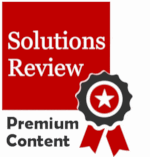Measuring Employee Experience in a Post-COVID World

This is part of Solutions Review’s Premium Content Series, a collection of contributed columns written by industry experts in maturing software categories.
 I’m an old-school advocate for employee experience. For years, my colleagues and I have urged (and cajoled, and begged) leaders to take the subject seriously. We argue that engaged and well-supported workers are the cornerstone of business success — and that nothing kills productivity quicker than when people can’t rely on the tools they need. That message has been getting through. It’s been gratifying to see more and more C-suites prioritize monitoring employee experience in recent years.
I’m an old-school advocate for employee experience. For years, my colleagues and I have urged (and cajoled, and begged) leaders to take the subject seriously. We argue that engaged and well-supported workers are the cornerstone of business success — and that nothing kills productivity quicker than when people can’t rely on the tools they need. That message has been getting through. It’s been gratifying to see more and more C-suites prioritize monitoring employee experience in recent years.
Then, COVID-19 hit. You can understand why many employee experience initiatives got put on the back burner. It’s hard enough to keep a business running during a pandemic. But when most of your workforce suddenly shifts to work-from-home, understanding employee experience becomes more important, not less. Not to mention that, for many businesses, large portions of the workforce will continue working remotely long after the COVID-19 crisis subsides.
Bottom line: “work” means something very different than it did a year ago. If we’re going to give people the support they need to thrive in this new normal, we need to rethink employee experience: what we measure, how we measure it, and what we can ultimately do about it.
Accelerating Longstanding Trends
For many of the changes we’ve seen—like huge growth in remote work and digital collaboration—COVID-19 didn’t so much create new models as it did kick pre-existing trends into high gear. The fact is, work has been growing more decentralized, and IT has been steadily losing control of business infrastructure for years. Just look at the major IT trends of the last decade:
- Core business applications moving from on-premise data centers to cloud-based software-as-a-service (SaaS)
- Dominant connectivity models shifting from Ethernet to Wi-Fi
- Explosive growth in mobile and remote work, often using devices outside IT control
Even if you care deeply about employee experience, it’s much harder to measure than it was back when everybody worked in the office and all applications, networks, and devices were controlled by IT. If employees are having issues, figuring out where to look becomes much tougher. The challenge grows exponentially when most of your workforce shifts to full-time work-from-home, practically overnight.
At this point, businesses need to put aside the deep metrics about application performance and start from ground zero: can my remote employees actually do their jobs? How are they feeling? Do they have the bare minimum they need to be productive?
Measuring the Right Things
If you’re in human resources—or really, any executive leadership role in your organization—it’s important to step back and look at employees holistically. We advocate measuring well-being across five broad categories:
- The basics: When companies are scrambling to react to an unexpected crisis, it’s easy to get caught by surprise. All of a sudden, you need to ask different kinds of questions: do my employees have the equipment they need? Not just a working laptop, but a good monitor and keyboard? A comfortable chair? A place they can work that’s free from noise and distractions? A fast and reliable network connection that can support video conferencing? These aren’t the kinds of things most companies have had to worry about before. They’re essential to employee well-being, though, so they need to be on your radar.
- User experience: Assuring a quality digital experience is relatively easy when everyone works in the corporate office. But if COVID-19 has taught us anything, it’s that we need our employees to be ready to work from anywhere, anytime. You’re better off thinking proactively about assuring digital experience, rather than waiting to react to the next big disruption. What are the core applications that each employee needs to do his or her job? Can they access those tools from home and use them as effectively as in the office? You’ll need more granular monitoring tools to find out. It’s not enough to know that a home user can connect to the Internet. Can they access all the apps they need reliably all day long? If not, why?
- Connectivity: Traditionally, most businesses treat remote work connectivity as a “best-effort” scenario. When you’re remote, you do the best you can. If you need business-class connectivity—guaranteed bandwidth under a service-level agreement (SLA), managed Wi-Fi, state-of-the-art performance monitoring—you come into the office. That’s no longer an option for millions of workers. So it’s more important than ever for IT to be able to look deeply into every user’s connection and troubleshoot problems all the way into home networks. For many connectivity issues, the problem lies with the user’s home network or local Internet service provider (ISP). Even if you can’t fix the problem, you can tell users what’s wrong and what they can do about it. Sometimes, that might be, “Your ISP is having issues and it could be a while. Focus on offline work for now.” That’s a lot better than hours of frustrated users and wasted IT effort trying to diagnose a problem they can’t solve.
- Device: Along those lines, it’s more important than ever to understand what’s happening on the employee’s device. For many problems, the cause is just a lack of memory or CPU power in older hardware. The good news is that those are among the easiest problems for IT to solve. However, if you’re not monitoring all the way to the device, it will take a lot longer to zero in on that.
- Applications and services: Businesses need to look outward when measuring employee experience, as well as inward. Yes, you need to know how employees’ devices and network connections are performing, but you should also be keeping tabs on your SaaS applications and cloud services. If, for example, Microsoft Office 365 is having slow performance across the southwestern United States, it would be useful for IT to know that before they spend hours trying to diagnose the problem.
Eliminating the Guesswork
The truth is, the list of issues outside IT’s control keeps getting longer, making visibility even more important. When you have hard data about what your people are actually experiencing, you can:
- Hold your SaaS and Internet providers accountable
- Empower employees (and reduce their frustration) by quickly diagnosing problems in their own devices and home networks that they can fix themselves
- Quickly identify problems beyond IT’s control so they can focus their time on tasks where they can make a real difference
We’re all still adjusting to the challenges of a post-COVID world. When your business relies on a remote workforce every day, just knowing what’s happening out there can be hugely beneficial.






















